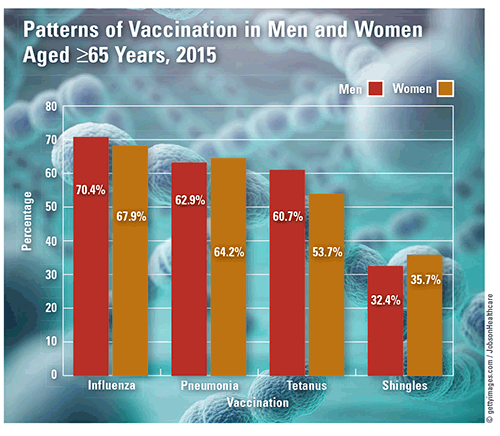US Pharm. 2019;44(4):36.

According to the National Foundation for Infectious Diseases, vaccines can protect elderly adults (age ≥65 years) from serious illnesses such as influenza, pneumonia, tetanus, and shingles.
Influenza Vaccination: In the previous 12 months, 69% of elderly persons received an influenza vaccination (IV), with men outnumbering women (70.4% vs. 67.9%). The IV rate jumped from 66.9% in persons aged 65 to 74 years to 71.7% in those aged 75 to 84 years, then increased by 1.5% in persons aged ≥85 years. IV was most common in non-Hispanic white persons (71.4%), followed by 65.9% of non-Hispanic Asian, 59.6% of non-Hispanic black, and 56.8% of Hispanic individuals. Nearly 72% of non-poor elderly people received IV, compared with 61.6% of those who were poor.
Pneumococcal Vaccination: Pneumococcal vaccination (PV) was administered to 63.6% of elderly persons, with the rate in women exceeding that in men (64.2% vs. 62.9%). Although there was no difference in rates between individuals aged 75 to 84 years (68.6%) and those aged ≥85 years (68.3%), PV was administered significantly less often to those aged 65 to 74 years (60.2%). PV was far more common in non-Hispanic white than in Hispanic persons (68.1% vs. 41.7%), and there was no difference between non-Hispanic Asian (49%) and non-Hispanic black persons (50.2%). Fewer elderly recipients of PV were poor (48.7%) than were near-poor (61.7%) or not-poor (66%).
Tetanus Vaccination: Over the past decade, the tetanus vaccination (TV) was administered to nearly 57% of elderly individuals, and more men than women received it (60.7% vs. 53.7%). The rate decreased in persons aged 75 to 84 years compared with those aged 65 to 74 years (52% vs. 61%), and the rate dropped an additional 8.5% in those aged ≥85 years (47.6%). TV rates were 59.4% in non-Hispanic white, 50.6% in Hispanic, 46.7% in non-Hispanic Asian, and 43.8% in non-Hispanic black persons. The socioeconomic variation in TV rates was notable: Elderly individuals who were not poor had a rate of 61% versus 49.1% in near-poor elderly and 41.1% in poor elderly individuals.
Shingles Vaccination: A little more than one-third (34.2%) of elderly people received a shingles vaccination (SV), and women had a higher prevalence than men (35.7% vs. 32.4%). The SV rate decreased from 35.9% in persons aged 65 to 74 years to 28.7% in those aged ≥85 years. Non-Hispanic white individuals (38.3%) were more likely than non-Hispanic Asian (30.6%), Hispanic (19.2%), and non-Hispanic black persons (14.1%) to receive SV. Among elderly individuals with a higher family income, SV prevalence was 39.6% versus 14.8% in poor individuals.
To comment on this article, contact rdavidson@uspharmacist.com.





